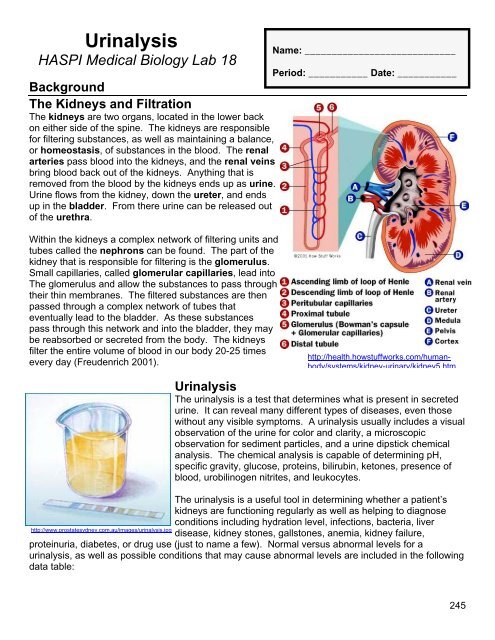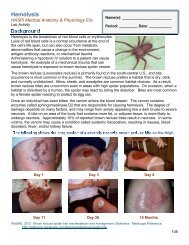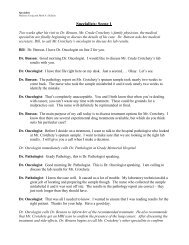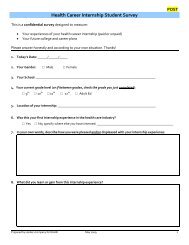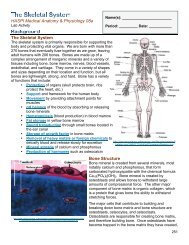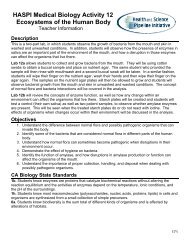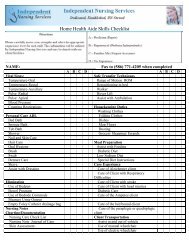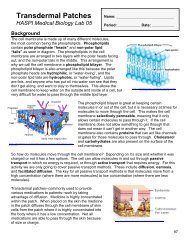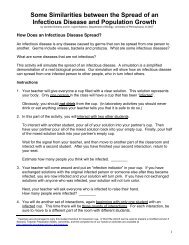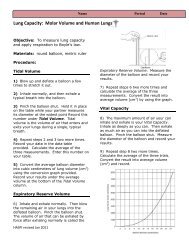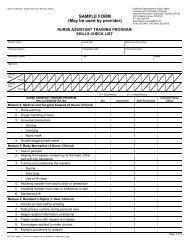18 Urinalysis - Student.pdf - haspi
18 Urinalysis - Student.pdf - haspi
18 Urinalysis - Student.pdf - haspi
- No tags were found...
You also want an ePaper? Increase the reach of your titles
YUMPU automatically turns print PDFs into web optimized ePapers that Google loves.
Name:____________________________________________ Date: ___________ Period: ________Materials5 ml Urine sample A 5 Test tubes 5 Urine test strips5 ml Urine sample B Test tube holder Test strip indicator5 ml Urine sample C Graduated cylinder 5 Plastic pipettes5 ml Urine sample D Slide Microscope5 ml Urine sample E Cover slip Paper towelsProcedurePurpose: The goal of this lab will be to perform a urinalysis on urine samples for 5 patients.Some background information for each patient is given below.Patient A: A 25-year-old male complains of feeling he “needs to go” all the time, but typicallyonly produces a small volume of urine. The patient experiences a mild degree of discomfort duringurination. He is also experiencing pain in his lower back.Patient B: A 28-year-old overweight male is experiencing excessive thirst (polydipsia), frequenturination (polyuria), increased appetite (polyphagia), and fatigue. He is also experiencingunexplained weight loss.Patient C: An <strong>18</strong>-year-old healthy female provided a urine sample for a routine physicalexamination. She had difficulty producing even a small volume of urine. The physician noted thatshe had only a 12-ounce diet soda and some carrots to eat all day.Patient D: A 17-year-old female complains of joint pain and an unusual rash. She does not eatany red meat or poultry, and her only form of protein is fish – primarily tuna – which she eats daily.Patient E: An elderly female patient presents with abdominal pain following meals. The conditionis more severe following a greasy meal.1. Label each of your test tubes A, B, C, D, and E. Place them in the test tube holder.2. Place 5 ml of each urine sample in the appropriately labeled test tube – USE A DIFFERENTDROPPER FOR EACH SAMPLE.3. Observe each urine sample for color and clarity. Refer to the Background Section forreference. Record your observations in Data Table 1.4. Place a drop of urine sample A onto the slide and place the cover slip over it. View urinesample A under the microscope to identify any sediment particles within the urine. If you seeANY sediment or crystals in the urine record a + in Data Table 1. If there are no visibleparticles record a – in Data Table 1.5. Clean off the slide and cover slip. Repeat step 4 for the remaining four urine samples.6. Place one of the urine test strips on a paper towel. Use the plastic dropper for the urinesample for Patient A to place urine on each of the 10 boxes on the strip. Each box requires 30-120 seconds and the time needed is for each test is on the urine test strip indicator sheet. Usethe test strip indicator sheet to compare your urine test strip. Record the value from theindicator sheet for each test in Data Table 1.7. Repeat step 6 for the remaining four urine samples.247
Name:____________________________________________ Date: ___________ Period: ________AnalysisNormalUrineColor YellowData Table 1Patient A Patient B Patient C Patient D Patient EClarityClearSediment NoneParticlesSpecific 1.015-Gravity 1.025pH 6-7KetoneGlucoseBilirubinRed BloodCellsProteinUrobilinogenNitriteLeukocytesNoneNoneNoneNoneNoneNoneNoneAnalysis Questions - on a separate sheet of paper complete the following1. Create a table that summarizes each patient, any abnormal results detected in their urinesample, and what possible conditions may have caused each abnormal result.2. Why is it important to develop a case history of the physical symptoms of each patient to beused along with the physical tests performed on the patient’s urine specimen?3. You receive two urine samples – one from the patient in the morning, and one from theafternoon. Would you expect the urinalyses to have the same results? Why or why not?4. The presence of blood in the urine can indicate a serious kidney problem. Why are kidneyproblems so serious?5. Suppose a urine sample revealed abnormal results, such as protein in the urine. If there isa result differing from the norm, should a physician always make an immediate diagnosis ofa disorder? Why or why not?6. How would the specific gravity of urine be different after a vigorous workout without theconsumption of significant quantities of water?7. The presence of ketones is often high in the urine of people with diabetes, and people whosuffer from anorexia. What characteristics do these two groups have in common?8. What factors would contribute to a very high or very low pH in urine?9. CONCLUSION: In 1-2 paragraphs summarize the procedure and results of this lab.248
Name:____________________________________________ Date: ___________ Period: ________Review Questions - on a separate sheet of paper complete the following1. What is the responsibility of the kidneys?2. How do the kidneys maintain homeostasis in the body?3. How does blood get into and out of the kidneys?4. How does urine leave the kidneys to be secreted out of the body?5. What is the filtering unit of the kidney called?6. How much blood do the kidneys filter daily?7. List 5 conditions that can be detected by a urinalysis?8. Can the diet affect the urine? How?9. Define the following urinary conditions: glycosuria, albuminuria, renal calculi, ketonuria,hematuria, pyuria, pyelonephritis, glomerulonephritis.\10. Identify and label the filtering units 1-6 and the parts of the kidney A-F in Figure A below.Figure A249
Name:____________________________________________ Date: ___________ Period: ________250


